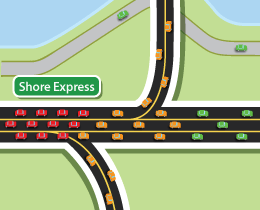Managing Heavy Electricity Use Areas
Within the PJM footprint, many population centers with high use of electricity are in the east, and the lower-cost generation is in the western portion of our footprint. As electricity use increases, the lower-cost western generation is increased to meet the demand. Power flows from west to east can reach the limits of the electric transmission system. For a comparison, think of the interstate highway system going from west to east, headed to the beach on a summer day. As more and more people head east to the beach, the interstate backs up, and traffic jams start to occur. If the interstate were to be closed, smaller roads would become overloaded because they cannot handle the increased volume of traffic. On the electric grid, situations like this could lead to widespread outages or even a black out.

PJM has created and monitors several groupings of transmission facilities, to prevent the possibility of widespread outages. To prevent transmission lines from becoming overloaded, PJM may use generation that costs more to operate to even out electricity flows. PJM looks at the actual power flows on transmission lines and takes a “what-if” approach to the loading on transmission lines. A computer program simulates the loss of equipment such as lines, transformers or generators and determines if the loss of a piece of equipment will cause bigger problems for the grid as a whole.
Staying with the trip to the beach comparison, these grid monitoring tactics equate to having people stationed at certain points along the routes to the beach keeping count of the number of cars going by. Before a route reaches its maximum capacity, any additional cars trying to enter the congested route would be diverted to other less congested routes. Taking these diverted routes could cause the distance traveled to increase, and, therefore, could increase the amount of fuel used. To further reduce the chance of gridlock, analyses could be done simulating an accident on a specific route and how this would affect all the remaining routes to the beach. Based on these analyses, the number of cars allowed on one route could be decreased even more, so that losing a route would not cause congestion on other roads.